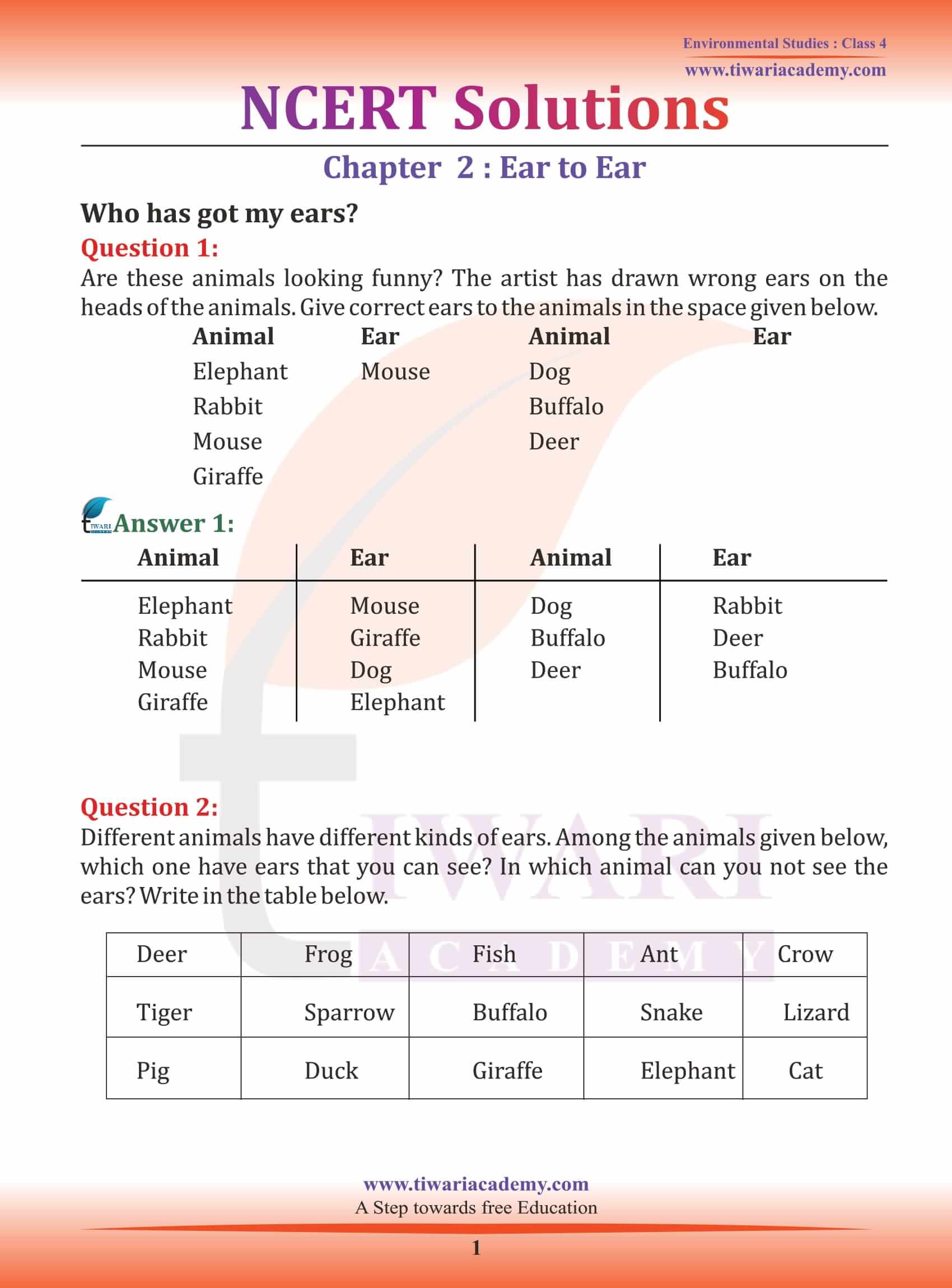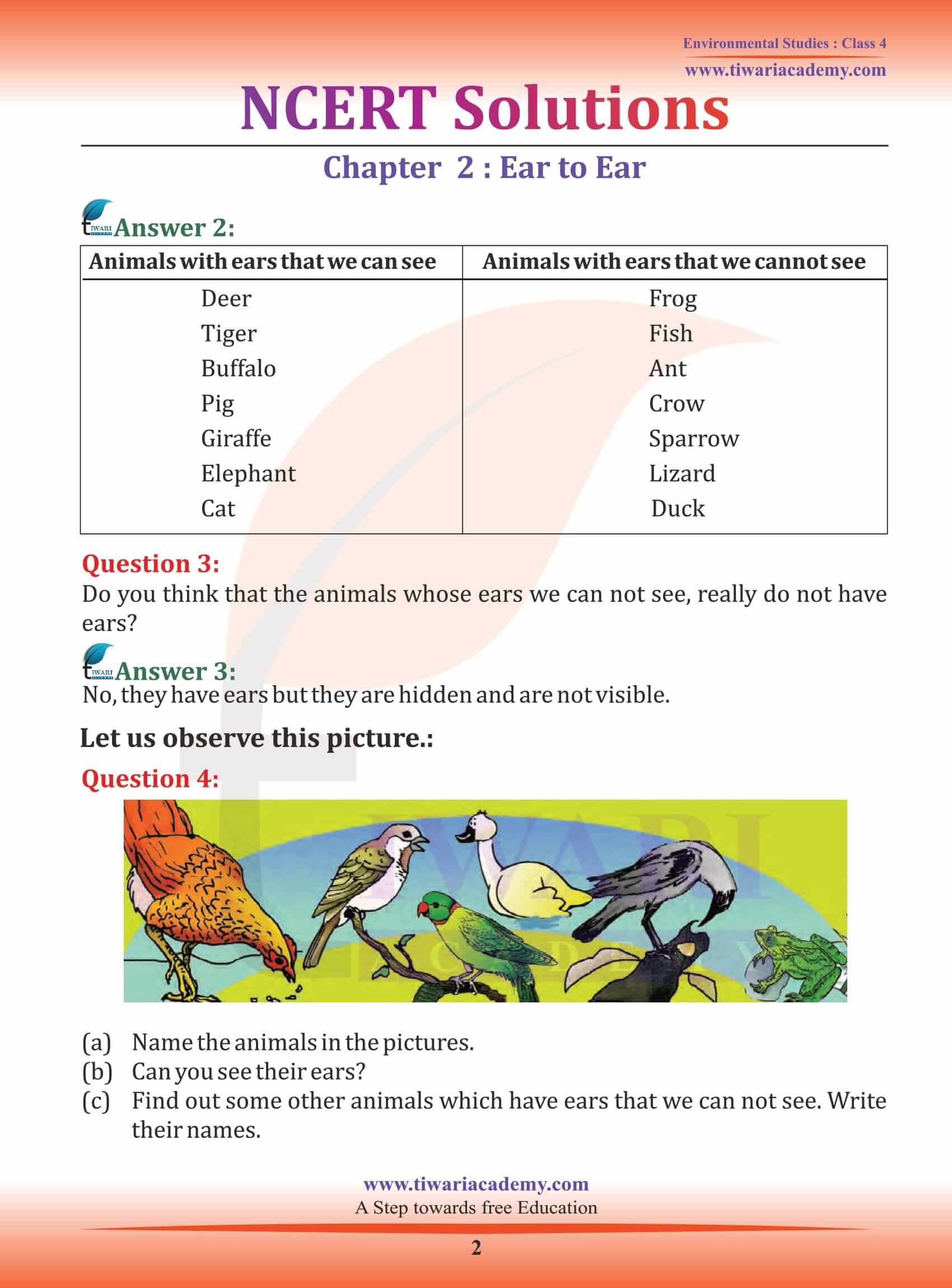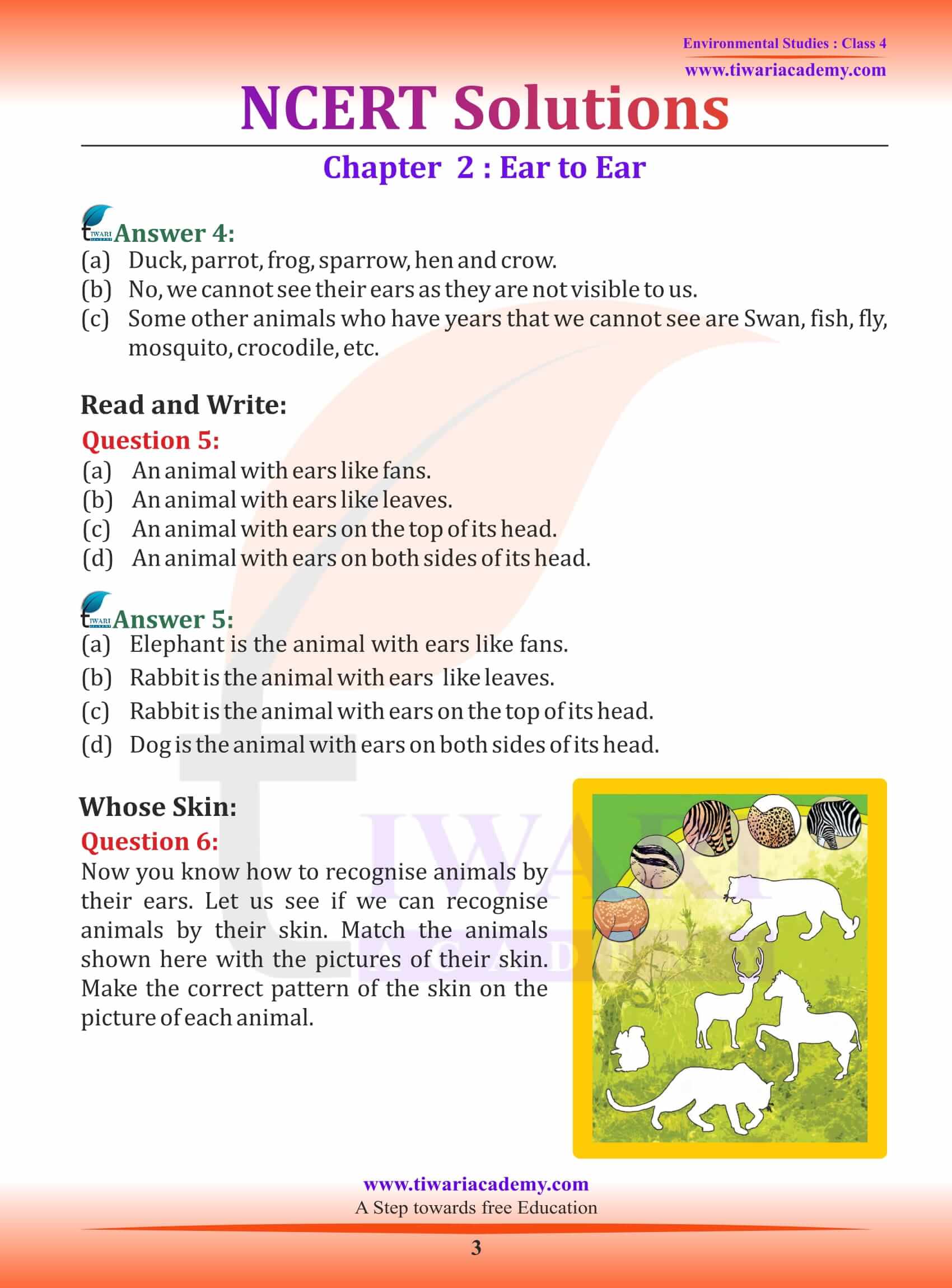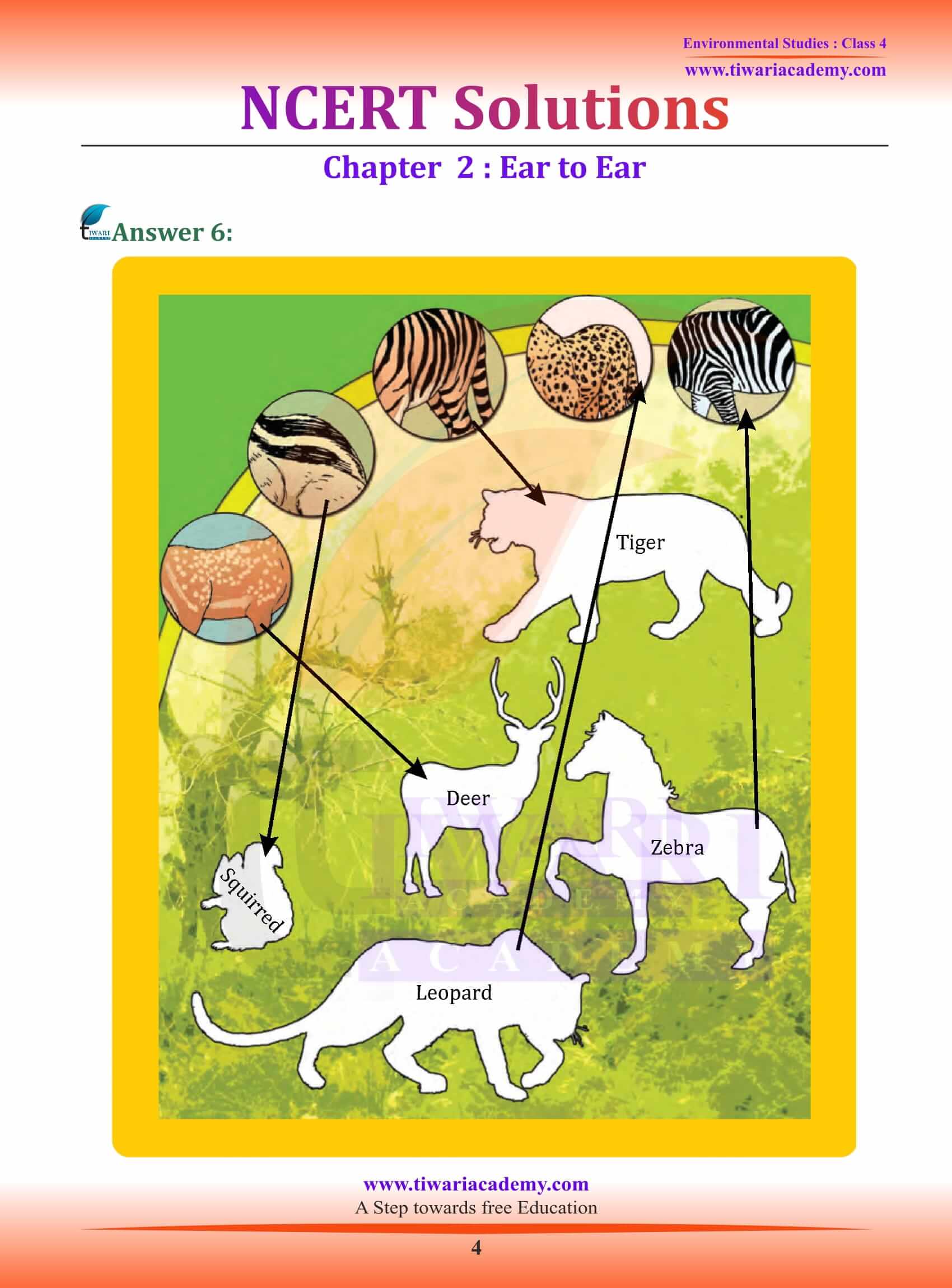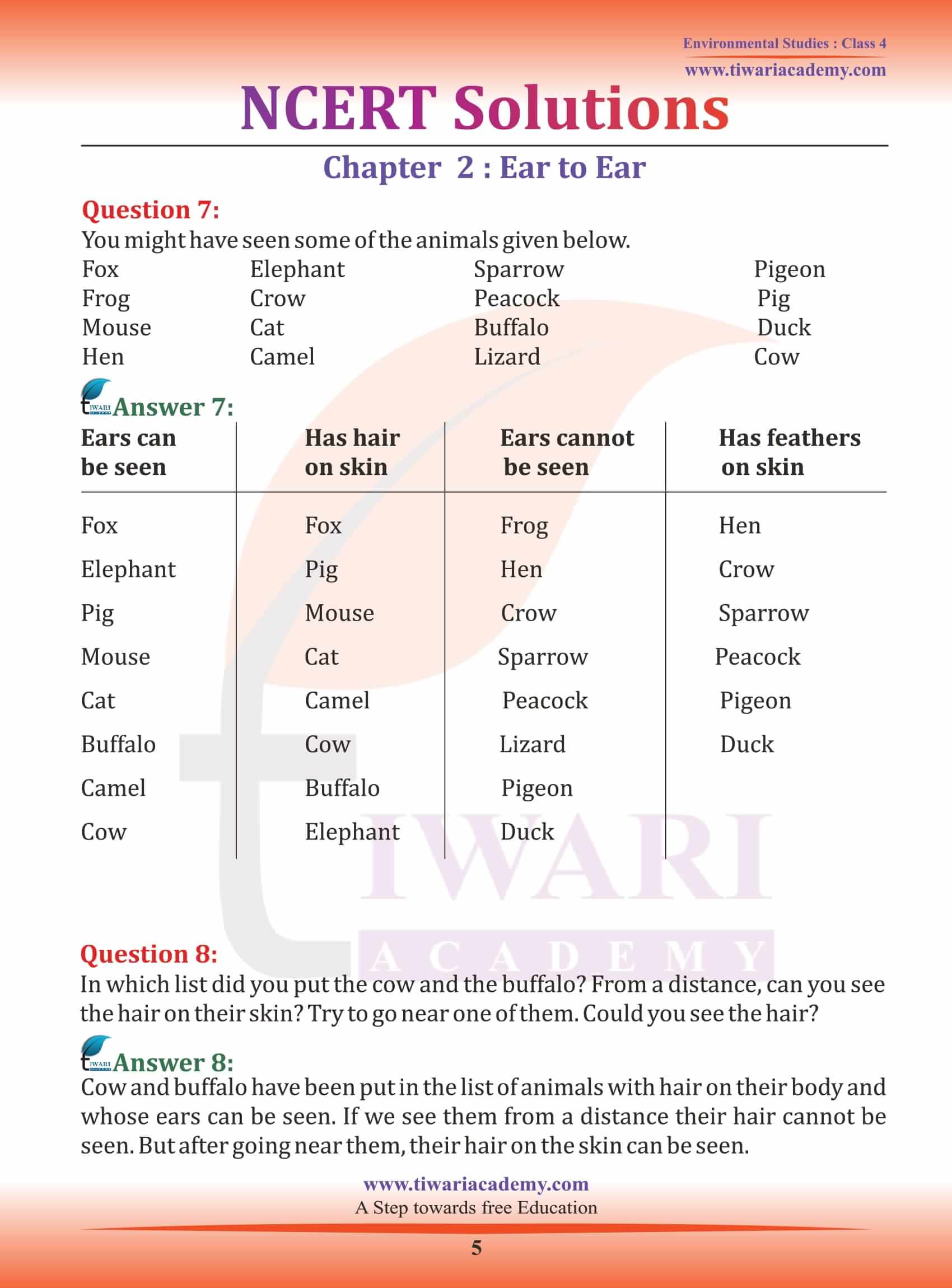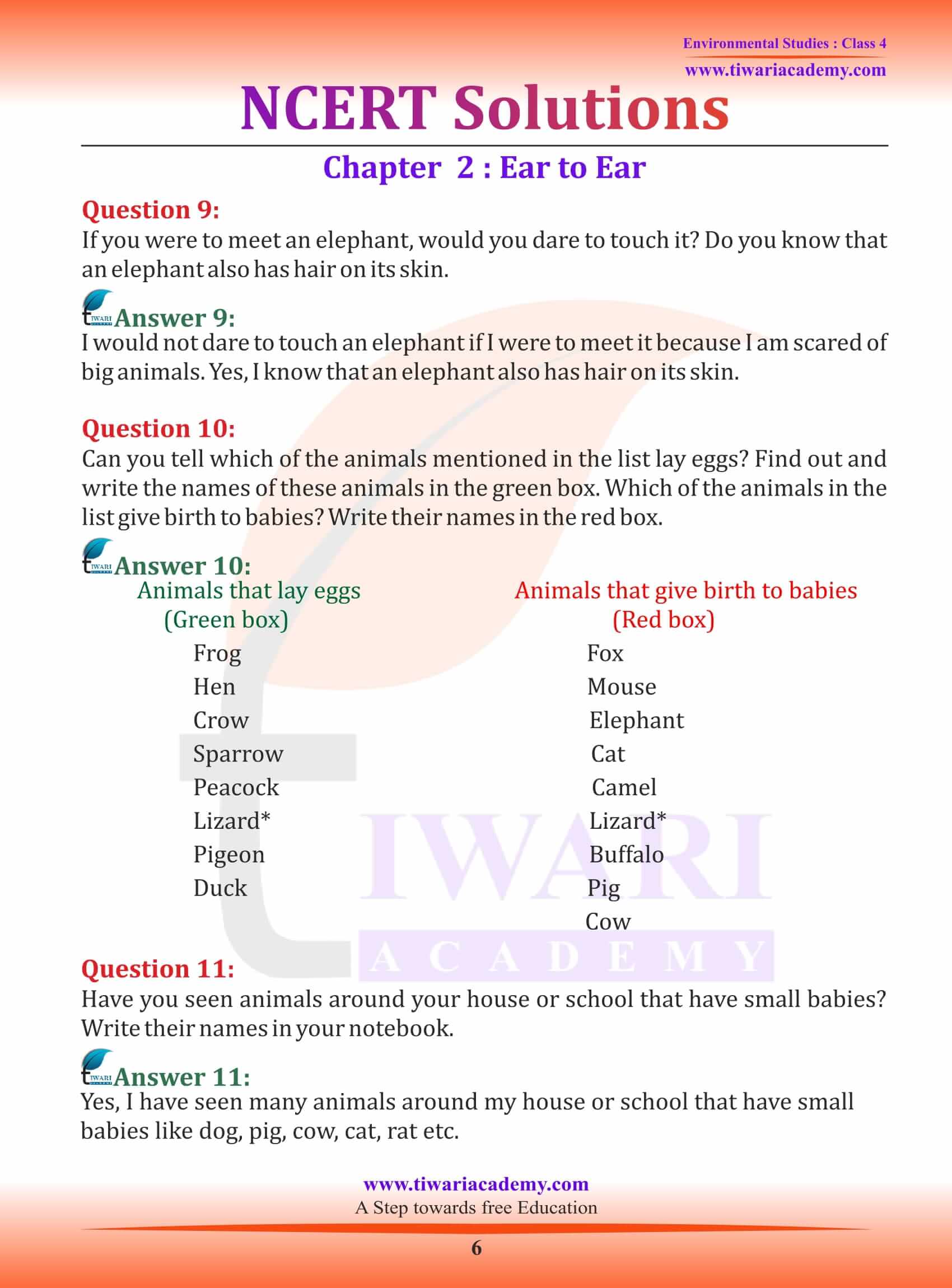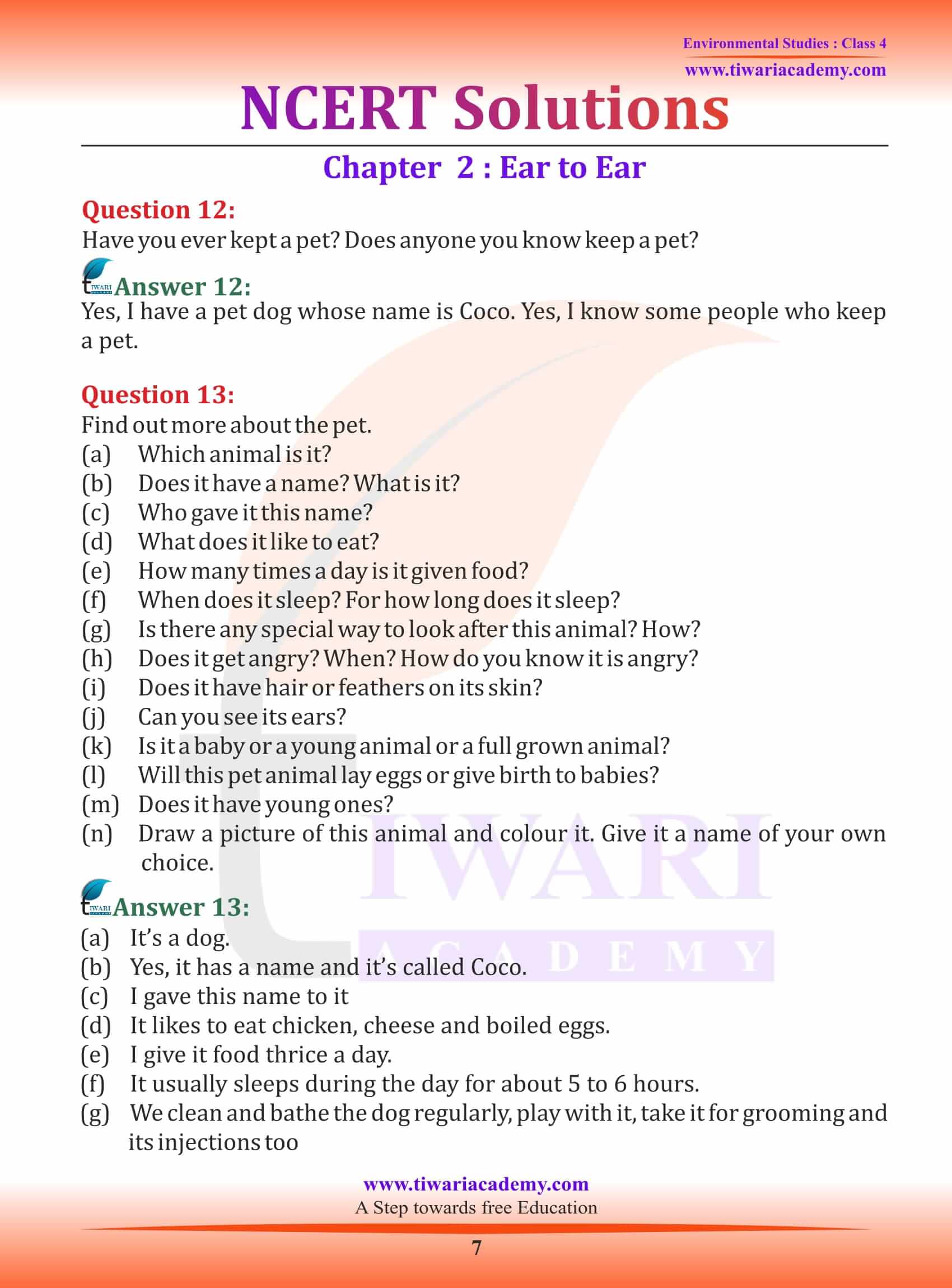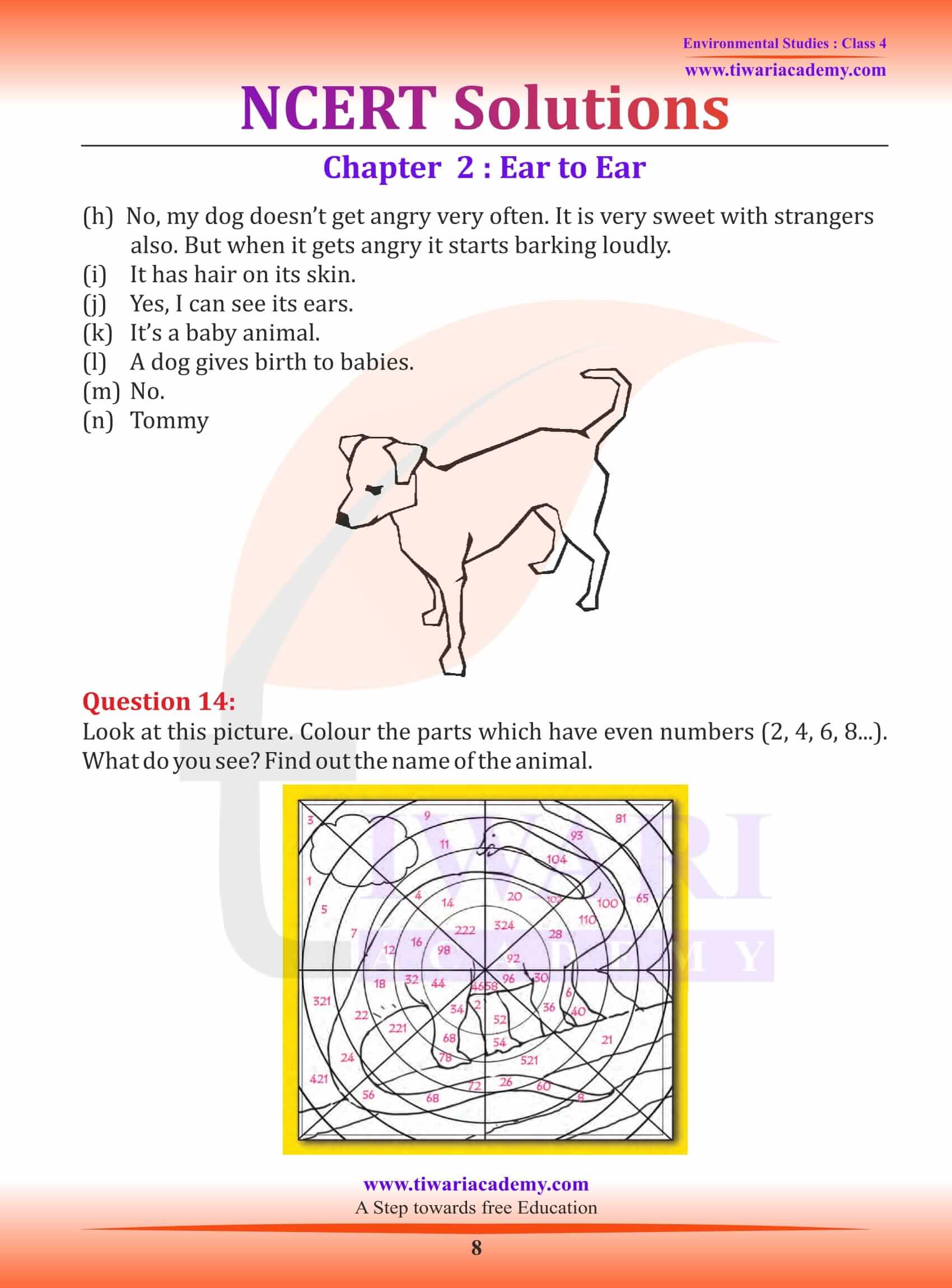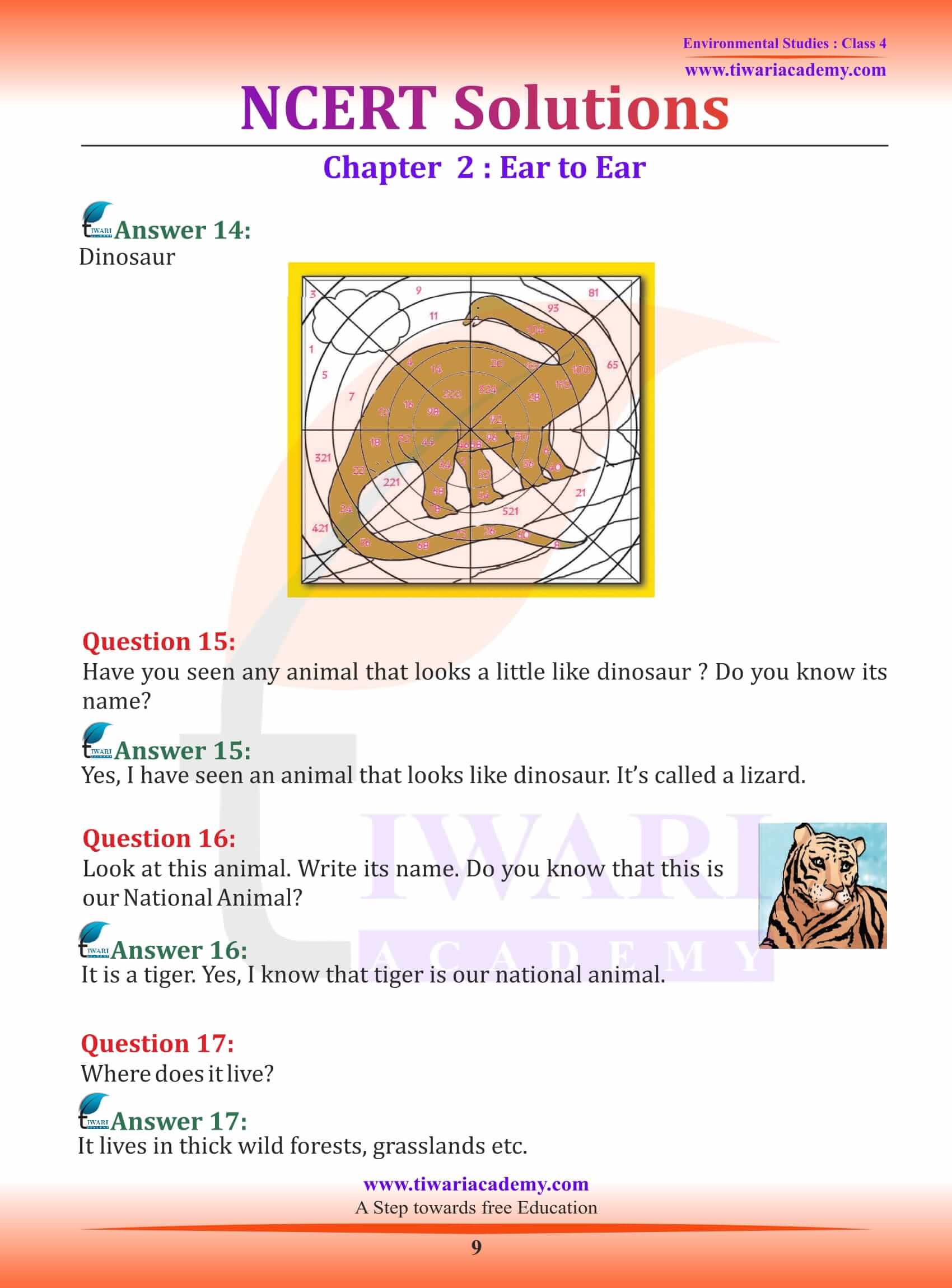NCERT Solutions for Class 4 EVS Chapter 2 Ear to Ear in Hindi and English Medium updated for academic session 2024-25 CBSE and State Board students free to use online or download in PDF. All the contents are made easy to understand format so that students can understand easily and prepare well for the exams. Extra question which are important for the term 1 and term 2 exams are also given with answer, so that students can prepare well for school exams.
NCERT Solutions for Class 4 EVS Chapter 2
Class 4 EVS Chapter 2 Question Answers with Important Extra Questions
Question:
Who has got my ears?
Answer:
Are these animals looking funny? The artist has drawn wrong ears on the heads of the animals. Give correct ears to the animals in the space given below.
| Animal | Ear |
|---|---|
| Elephant | Mouse |
| Dog | Rabbit |
| Buffalo | Deer |
| Mouse | Giraffe |
| Giraffe | Elephant |
Question:
Different animals have different kinds of ears. Among the animals given below, which one have ears that you can see? In which animal can you not see the ears? Write in the table below. Deer, Frog, Fish, Ant, Crow, Tiger, Sparrow, Buffalo, Snake, Lizard, Pig, Duck, Giraffe, Elephant, Cat.
Answer:
Animals whose ears we can see and animals whose ears we cannot see given below:
| Animals whose ears we can see | Animals whose ears we cannot see |
|---|---|
| Deer | Frog |
| Tiger | Fish |
| Buffalo | Ant |
| Pig | Crow |
| Giraffe | Sparrow |
| Elephant | Snake |
| Cat | Lizard, Duck |
Class 4 EVS Chapter 2 Question Answers Set 1
Do you think that the animals whose ears we cannot see, really do not have ears?
In some animals we can see the ears, in some we cannot. No, they have ears in tiny shape which are not visible. We cannot see a bird’s ears. A bird has tiny holes on both sides of its head. Generally, the holes are covered with feathers. They help the bird to hear.
Have you seen animals around your house or school that have small babies? Write their names in your notebook.
We Have seen animals around our house or school that have small babies for example cow, pig, dog and several types of bird.
Have you ever kept a pet? Does anyone you know keep a pet?
Yes, we have several pets when I was lived in my village like cow, buffalo etc. now in cities trend has been changed I know several people who keep pet like dog and cat.
Which animal is it?
This is a little puppy.
Does it have a name? What is it?
Yes, his name is “tomy”.
Question:
Who gave it this name?
Answer:
This name given by his master’s little daughter.
Class 4 EVS Chapter 2 Question Answers Set 2
What does it like to eat?
He like to eat milk and rusk.
How many times a day is it given food?
In a day it is given food three time.
When does it sleep? For how long does it sleep?
He is a lazy puppy, it sleeps mostly.
Is there any special way to look after this animal? How?
Pet animals require lot of care specially dogs. First of all, keep in mind their hygiene for good health and feed them carefully and on right time. We should fix the time for outing.
Class 4 EVS Chapter 2 Question Answers Set 3
Does it get angry? When? How do you know it is angry?
He gets angry when some tease him or when someone unknown person enters in house. When he becomes angry barking loudly and jumping here and there.
Does it have hair or feathers on its skin?
It has hair on its skin
Can you see its ears?
Yes, we can see its ears.
Is it a baby or a young animal or a full grown animal?
It is a baby animal.
Will this pet animal lay eggs or give birth to babies?
This pet animal give birth to babies.
Does it have young ones?
No, it is itself a small puppy.
Class 4 EVS Chapter 2 Extra Question Answers Set 1
How does an elephant use its ears?
An elephant uses its ears in the following ways-
• To hear long distance sounds
• To keep its body cool
• To communicate joys and sorrows, show anger, excitement by flapping the ears
Why do elephants keep flapping or moving their ears?
Elephants keep moving or flapping their ears in hot weather to keep their body cool. Flapping the ears helps to cool an elephant as the ears act as a fan and move air over the rest of the elephant’s body, flapping also cools the blood as it circulates through the veins in the ears.
How are bats ears a substitute for its eyes?
Bats have large ears on their small head which help them to navigate or find their way in the dark as their vision is not good in comparison to the other animals.
How do bats fly to find their prey?
Every night a bat puts in 600-700 kilometres of airtime. Flying at a low level, the bat catch insects at speeds of around 40 metres per second. At night, the bat uses its ears which are good at hearing to find its prey. Bats catch insects continuously using sound which as a navigation system.
How does hair on an animal’s body help them?
Hair on the body is a body covering that –
• Keeps the animal warm and dry
• Gives different pattern to the animal on their skin
• Protects them from any danger like enemies
• Protects them from harsh weather conditions
• Helps them to hide from their enemies (Camouflage)
Mention a few features of mammals.
The features of the mammals are as given below-
• They give birth to their young ones directly
• Most of them live on land
• They have four limbs
• They have hair on their body
• The young ones feed on their mother’s milk
• They have ears which can be seen
Who are mammals?
Mammals are the organisms which have mammary glands to produce milk, they give birth to young ones and have hair on their body. They are also warm blooded e.g., human beings, cat, dogs, monkeys, cow etc.
Question:
How are ears useful to animals?
Answer:
The ears are useful to animals as –
• Ear is an important organ that is used for hearing. Animals use their hearing power to sense danger/enemies and to find their prey
• It helps in maintaining balance of the body in mammals.
• In some animal ears help to keep their body cool. For eg: Elephant.
Class 4 EVS Chapter 2 Extra Question Answers Set 2
What does reproduction mean?
Reproduction is the process by which the living things produce young ones of their own kind. Some living things reproduce by laying eggs and some give birth to the young ones directly.
Why is reproduction necessary?
Reproduction is an important process which helps animals to-
• Increase the number of animals
• Prevent extinction of animals
• Maintain continuity of life.
Mention the different ways in which the animals reproduce?
The animals reproduce by two ways-
• By laying eggs- birds, reptiles, fish and amphibians
• By giving birth to the young ones directly-mammals
How do the birds hear?
Hearing is birds’ important sense, and their ears are funnel-shaped which help them to hear sound. The ears are located slightly behind and below the eyes, and they are covered with soft feathers. Although the birds do not have external ears, their ears help them to identify sounds coming from different levels. Birds are also able to make out whether the source of a sound is above them, below them, or at the same level.
Why do animals have different patterns on their body?
There are different patterns on the animal body due to the hair on their skin. If the animal did not have any hair on its skin then there would be no patterns. These patterns or stripes present on the body of animals match with their surroundings like grass, plants etc and are very useful for them. The patterns prevent animals from being spotted by the enemies. For e.g. when zebra hides itself behind the grass, these stripes confuse the enemies in identifying it and thus protects it
Why are the tigers decreasing in numbers in India?
India has a habitat to support about 10,000 tigers in the country, but the number of tiger is decreasing day by day due to the cutting of forests resulting in loss of habitat and less availability of preys to feed on. Thus human activities, such as hunting, poaching and habitat destruction, are the reasons why some species of tigers have declined over the years.
How does a snake hear?
Snakes do not have external ears but they can hear the vibrations with the help of their internal ear which are present in their jaw bones. Snakes feel the waves of the sound and transfer it to the internal ear to take action. Snake moves its body in response to the sound waves obtained from it.
Why are a bird’s ears not visible to us?
A bird’s ears are not visible to us because it does not have external ear structures. Its ears are like openings that are hidden under the feathers on the side of the head, just behind and slightly below the eyes. Birds do have ears and an excellent sense of hearing and are able to hear a much wider range of sounds than humans, but we can’t see their ears because they are covered with feathers. The feathers that cover the ear hole protect it from the noise of the wind as the bird flies.
Class 4 EVS Chapter 2 Extra Question Answers Set 3
What is the reason that animals can be recognised by their skin?
Animals can be recognised by skin due to the smell generated by the sweat glands present in the skin of animals.
Do crocodiles have ears?
Crocodiles are the only reptiles with external ear. Their ears are located behind their eyes, in the upper part of their heads. They have flaps which cover their ears forming a tight seal, preventing water from entering the ear when they are in water.
What type of ears do bats have?
Bats have large ears. Bats have a bad eyesight, being blind for the most part so they depend upon their sense of hearing. A bat can shrill at the same time as in flight and navigate their way to where they need to be.
What type of mammal is a platypus?
Platypuses are grouped as separate type of mammals which are different from all other mammals because they do not give birth to the young ones directly but they lay eggs.
Why is a platypus considered a mammal?
The platypus is considered a mammal because it has fur on its body and feeds its young with milk.
What is pangolin?
Pangolins are actually mammals. They are the only mammals whose whole body is covered in scales and they use those scales to protect themselves from enemies in the wild.
What makes a pangolin a very unusual mammal?
Pangolins are covered in hard scales. These mammals eat ants and termites using an very long, sticky tongue, and are able to quickly roll themselves up into a tight ball when they feel threatened.
What are nocturnal animals? Give examples.
Nocturnal animals are those animals that are active at night time and then sleep during the day. There are many examples of nocturnal animals, including hedgehogs, foxes, owls, bats. Since they are awake when it is dark outside, their bodies adapt them to survive.
Class 4 EVS Chapter 2 Extra Question Answers Set 4
What are diurnal animals?
These animals are active during the night hours. Animals that are diurnal are usually awake and active during the day. These animals are well adapted to live during daylight. Many diurnal animals are inactive during night time because their body temperature drops at night. Examples include human, many birds, deer, cows etc.
Write one use of each of the following, for mammals:
(i). Hair -The most important function of hair in mammals is that it prevents the body against cold by conserving body heat. The different colours and colour patterns in hair coats also serve purpose of camouflage.
(ii). Ear- The ear is the organ that enables the mammals to hear and maintain balance of the body.
Why do animals move their ears?
Many animals move their ears to focus their attention on sound. Many animals, including dogs, cats and various species of monkeys move their ears for better focus.
What are the features of fish to live in water?
The features which help fish to adapt to live in water:
• It has streamlined body which is covered with scales.
• The skeleton is made up of thin bones with a flexible backbone.
• It is a cold blooded animal with flat fins
• fins and tails help them swim and also help to change direction and keep the body balanced.
• Gills that are the organs used for respiration in fishes. They are capable of absorbing oxygen from the water.
What are reptiles?
Reptiles are a group of cold-blooded animals which have skins covered with small hard plates called scales.They breathe through lungs and reproduce by laying eggs. Their skin is dry, and rough, without any glands. The body is divided into head, neck, trunk, and tail. Example-Snakes, lizards, and crocodiles are reptiles.
What are amphibians?
Amphibians are a class of animals like reptiles, mammals, and birds. They live in the water and on the land. When they hatch from their eggs, amphibians have gills so they can breathe in the water. They also have fins to help them swim, just like fish.
What is a vertebrate?
A vertebrate is an animal that has a backbone and a skeleton. It includes humans. It refers to those animals who have a backbone that protects their spinal cord.
What is hibernation?
Hibernation is also known as winter sleep. The warm and cold blooded animals undergo hibernation. It is a inactive stage in which all the activities of animals slow down. They maintain constant body temperature.
Question:
Differentiate between diurnal and nocturnal animals.
| Nocturnal animals | Diurnal animals |
|---|---|
| They are the animals that are active during the night hours. | They are the animals that are active during the day hours. |
| These animals have cells for proper night vision. | These animals have cones for proper daylight watch. |
| They communicate by the means of sounds only. | They use different methods for communication. |
| Examples are bats, owls and some reptiles | Example includes human, birds, deer |
What does chapter 2nd of class 4 EVS focus upon?
The chapter 2nd of 4th standard EVS majority focuses on the diversity in the animal kingdom and tried to make you understand the following things:
• How does the change in the animal body parts make them look and it is experimenting?
• What happens if you change the skin of one animal to another?
• Some playful questions for the children so that they can understand the vivid varieties and importance of the animal kingdom.
Do you think 4 class EVS chapter 2nd is easier to cover without any activities?
The major thing in this chapter is to understand the animal kingdom and how to recognize then and what happens if someone chooses to change the appearance of one animal with another’s. That is practically not possible whiteout harming the animal but it will for sure give the child’s creativity a wild run so that they make their own animals and in the path of doing so they will understand what animal have what part.
And this required activity to draw and imagine the animals and without it is not possible to study effectively.
What can you suggest as an effective way of completing the 2nd chapter of class 4 EVS?
In EVS chapter 2 of class 4 needs to be understood fairly. Otherwise, child curiosity of understanding the animal which is the vital part of the animal planet will not be properly developed, and this is not good.
So, I suggest the effective way of completing the chapter is to make a list of animals and draw them and write about them and then complete the chapter. This is how they will understand which animal you are talking about. The EVS is about the science we are surrounded by. Nevertheless.
How difficult is the class 4 chapter 2nd of EVS?
The chapter is fairly easy and interesting for the children as we understand that we all love and like animals which make this chapter one of the favorite and easy-to-understand chapter. On top of it, the chapter is made in such an interactive way that children hold their focuses upon studies.
Why do you think that knowing about the animals is relevant for the class 4 child in the book of EVS chapter 2nd?
We are living in a world where the interaction of children to the animals other than domestic one is very less in these times the chapter such are given are important for them to know about the food chain.
Other than that more and more animals are going to extinct because of what the zoo and national park are being careful and so book interaction for the knowledge in relevant as well as important.
